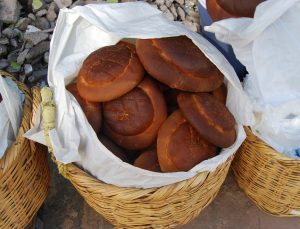The Meaning of Food in Cuzco
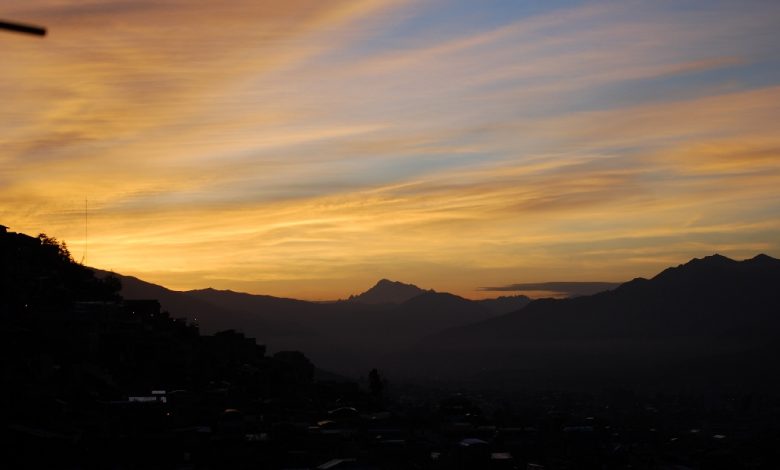
Potatoes are beginning to sprout on the hill sides around Cuzco. It is spring. The rains have started. Soon the hillsides will turn green with rich vegetation and beautiful, purple flowers while underground tubers turn from almost nothing to become large and fleshy. The growth of potatoes underground not only makes the hills verdant, it makes life in Cuzco make sense.
Look at food. Where Arequipa Street opens from Maruri, as if an opening into the Plaza de Armas, women sell paper wrapped bundles of delight. As if a furrow the paper encloses a myriad of relatively small, golden round fritters like potatoes clumped in the dirt of the earth.
Buy one, bite into it and you find another world. Layers of egg and then spicy rocoto pepper open to show a picadillo, a dice, of cooked and seasoned potatoes, carrots, and ground meat.
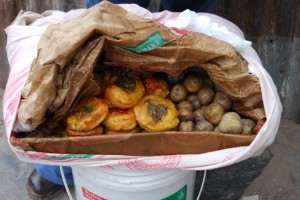
This is Cuzco’s famous rocoto relleno, stuffed pepper. The city of Arequipa claims them as their own in the fight for regional, typical foods in Peru. But Cuzco’s are different. Unlike those in Arequipa they are enclosed in a batter as if wrapped in the earth.
Cuzco’s rocotos rellenos often come with another festive food lechón, something served throughout the year in Cuzco. Lechón is roast pork (technically roast piglet). Like potatoes, before the pork is eaten it rests open in the sun to cure. For potatoes that is part of the process of harvesting them, at the same time it is part of making the dried potatoes, moraya and chuño, that are so much a part of Cuzco’s diet.

Before being served, however, the pork must enter a hot oven like going into the earth. From there it comes out steaming and rich, fully scented and enticing for people to eat with their hands while often sitting under the sun.
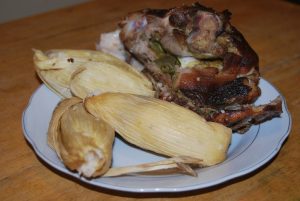
People generally associate the sun with corn, another major food stuff in Cuzco. After all corn plants rise straight and tall to reach for the sun. In Cuzco’s valleys corn is also rising. Soon its tassels will shake in the sunlight and on its stems another wrapped bundle of small food will grow.
Like potatoes, corn is a key that unlocks Cuzco’s life. For the Incas corn, ground and made into a bread, sankhu, was a major offering to the sun and other deities.
Both potatoes and corn start life wrapped. Potatoes in the womb of the earth and corn in its husk with hair-like silk. If rocotos rellenos remind one of potatoes in the earth, tamalesin their cylindical form, wrapped and steamed in corn husks, the very husks that embraced the green corn, remind one of the corn.
To eat tamales you first must remove them from their wrappings . Then you bite into the corn dough, made from corn dried in the sun before being soaked, ground, formed, and steamed. Inside you find a filling: a bite of spicy ground pepper, meat, and an olive.
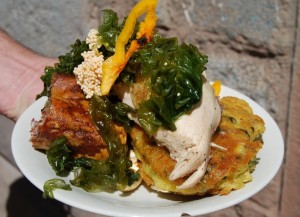
Like the valley floors and hillsides, where the potatoes and corn grow, food in Cuzco often comes in twos. So sometimes the two is lechón, rich roast pork with a potato and a tamale. Other times it is the lechón with a potato, as well as a tamale and a rocoto relleno at its side.
Another way to think of this stuffing inside of something else, is to think of layers like a landscape with one field higher than another. This is like other dishes from Cuzco such as the famous chiriucho that is the most known festive dish. Here elements from all over Cuzco and its landscape, including the distant sea coast and the grassy altiplano by Lake Titicaca, are layered carefully into a mountain of food for people to eat little by little.
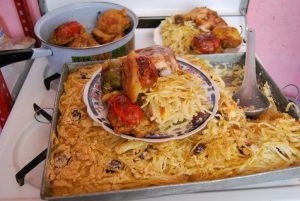
It is also like the baked fettuccine, the tallarines al horno, that is another common family and festive food in Cuzco.
But underlying all of this mountain of food is still the earth from which the corn seeds germinate to rise high and within which potatoes are beginning to grow. In that is the basis of grasping food and life in Cuzco.
